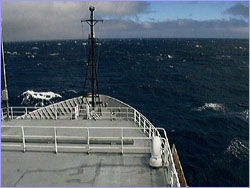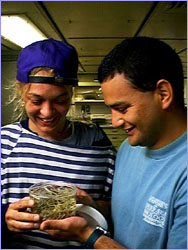
|
 |
 |
by Peter Tyson July 15, 1998 Yesterday a low-pressure zone swept in, bringing 30-knot winds, ten-foot seas, and ROPOS operations to a screeching halt. It was as if Poseidon, reading exhaustion in the faces of the scientific party after a successful week of retrieving chimneys, suddenly declared, "Whew, let's take a break." With the R/V Thomas G. Thompson groaning through stomach-turning pitches, many retreated shakily to their rooms. The main lab, library, and ROPOS room, all usually buzzing with activity, were silent, and the half-empty mess at meal-time revealed that a few of us were a tad under the weather. By this morning, the seas had calmed, and people began to appear in the passageways again. While we waited for ROPOS to get to the seafloor, I took the opportunity to catch up with the biologists, who are studying the bizarre life forms living in and around black smoker chimneys in search of clues as to how life began on Earth. You haven't heard much about the biologists, because the focus of the first fortnight was on the engineers and geologists preparing and collecting the chimneys. But they've been here all along, silently going about their work and patiently waiting for the next "bio dive." One is taking place right now, as I write. It is led by Jozee Sarrazin, a vibrant, French-speaking post-doc at the Woods Hole Oceanographic Institution, and Istvan Urcuyo, a gregarious, Nicaraguan-born graduate student at Pennsylvania State University. They are collaborating on a project to minutely characterize the community of life that lives on a single sulfide chimney. While biologists intimately know the denizens and workings of tiny patches of rain forest and coral reef, they have conducted few in-depth studies of this kind on hydrothermal vent habitats. Such communities were only discovered 20 years ago, and the environment they inhabit is extremely difficult to work in, so many unknowns remain. For example, Urcuyo says that of the more than 300 species of vent life discovered so far, biologists can follow the life cycle of only about three or four.
Urcuyo is working with her to define, in addition to the overall biomass, the composition, distribution, and abundance of vent animals on selected chimneys. On a ROPOS dive two days ago that he and Sarrazin directed, Urcuyo had the pilot on duty scoop a sample off the biologically bristling chimney Gwenen using a device called the Chimney Master. Like a vacuum-cleaner bag with fingers, the Chimney Master grabs a known surface area of material and delivers it to ROPOS' biobox. Later, in the main lab, a number of us chipped in to help Urcuyo and Sarrazin sort the creatures by species. The sample was from a high-flow Community 5, which is dominated by R. piscesae tubeworms living in medium-high temperature water. The tubeworms were there in abundance, along with tiny brown limpets, scale worms, and several species of polychaete worms. There was also a single sea spider and perhaps a thousand snails of the wonderfully named species Depressigyra globulus. Meanwhile, Jon Kaye, a graduate student at the University of Washington, told me about the microbial life he and his advisor John Baross are focusing on. After each of the four chimneys we collected was lifted onto the deck of the CCGS John P Tully, Kaye and Baross cored them from edge to center. They're hoping to find out what species live where within different types of chimneys, and what their relationship is with the geology. For example, do some microbes prefer living on silica while others go for anhydrite? When the Tully departed, Kaye joined us here on the Thompson to continue his search for microbes that live in high-temperature, high-salt-content conditions. No one had ever seen these before, but already Kaye thinks he has cultured some in his broth tubes. Pulled up from the deep sea, these microscopic creatures have grown in his incubator at temperatures reaching185°F—hence their technical name, hyperthermophiles. Will they replicate? Do they prefer or even require super salinity? The latter would prove they were spewed out from some subsurface community that has those conditions. Otherwise where did they come from? "It's all based on Darwinian evolutionary theory, that they exist for a reason," said Kaye, a lithe, rust-haired man in his early 20s. "And what might that reason be?" I asked. "Why would anything willingly opt for hyper salinity?" "Well, maybe they began there and later adapted to live outside of vents. Perhaps we're all descended from high-salt-tolerant hyperthermophiles." Such talk has been floating about this ship since we left port. I'd better listen in while I can, for the word's out that another low-pressure system is on the way, with even higher winds predicted. The ROPOS dive now underway may be our last before we begin our 18-hour sail back to Seattle tomorrow night. Peter Tyson is Online Producer of NOVA. The Tug of the Thompson (June 23) The ROPOS Guys (June 25) In the Juan de Fuca Strait (June 27) Special Report: A Visit To Atlantis (June 29) Dive 440 (July 1) Rescue at Sea (July 2) What's Your Position? (July 4) Phang! (July 5) 20,000 Pounds of Tension (July 8) Four for Four (July 11) Thrown Overboard (July 13) Was Grandma a Hyperthermophile? (July 15) Swing of the Yo-Yo (July 18) The Mission | Life in the Abyss | The Last Frontier | Dispatches E-mail | Resources | Table of Contents | Abyss Home Editor's Picks | Previous Sites | Join Us/E-mail | TV/Web Schedule About NOVA | Teachers | Site Map | Shop | Jobs | Search | To print PBS Online | NOVA Online | WGBH © | Updated October 2000 |
 The Thompson heads into 30-knot winds.
The Thompson heads into 30-knot winds.
 Jozee Sarrazin and Istvan Urcuyo examine tubeworms.
Jozee Sarrazin and Istvan Urcuyo examine tubeworms.